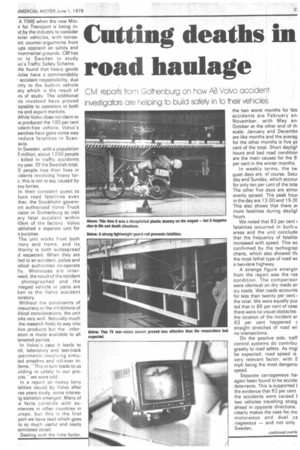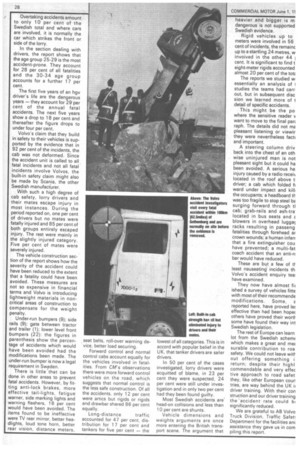Cutting deaths in road haulage
Page 29

Page 30

If you've noticed an error in this article please click here to report it so we can fix it.
CM reports from Go enburg on how AB Volvo accident investigators are heiping to build safety in to eir vehicles.
A TIME when the new Min
for Transport is being in)d by the industry to consider 3vier vehicles, with consetnt counter-arguments from ups opposed on safety and ,ironmental grounds, CM has tn to Sweden to study vo's Traffic Safety Scheme. Ne found that heavy goods iicles have a commendably accident responsibility, due inly to the built-in vehicle ety which is the result of irs of study. The additional ;ts involved have proved :eptable to operators in both ne and export markets.
While Volvo does not claim to te produced the 100 per cent :ident-free vehicle, Volvo's earches have gone some way reduce fatalities in Scanavia.
In Sweden, with a population 3 million, about 1200 people killed in traffic accidents try year. Of the Swedish total, 0 people lose their lives in :idents involving heavy lors; this is not to say caused by tvy lorries.
In their constant quest to luce road fatalities even /her, the Stockholm governmt authorised Volvo Truck tision in Gothenburg to visit ery fatal accident within 10km of the factory. Volvo :ablished a separate unit for s purpose.
The unit works from both :tory and home, and its thority is both widespread d respected. When they are 'led to an accident, police and adical authorities co-operate Ily. Witnesses are intermed, the result of the incident photographed and the maged vehicle or parts are ken to the Volvo accident )oratory.
Without the constraints of ireaucracy or the inhibitions of ditical considerations, the unit )rks very well. Naturally much the research finds its way into )Ivo products but the inforation is made available to all terested parties.
In Volvo's case it leads to :Id, laboratory and test-track cperiments involving simuted smashes and roll-over indents. -This in turn leads to us Jilding in safety to our prorcts,we were told.
In a report on heavy lorry talities issued by Volvo after ree years study, some interes-ig statistics emerged. Many of ie facts coincide with ex?riences in other countries in :Hope, but this is the first port we have read which goes to so much useful and easily ;similateld detail.
Dealing with the time factor, the two worst months for fate accidents are February an November, with May an' October at the other end of th scale. January and Decembe are like months and the averag for the other months is five pE cent of the total. Short dayligh hours and bad road condition are the main causes for the 6 per cent in the winter months.
In weekly terms, the tw quiet days are, of course, Satui day and Sunday, which accour for only ten per cent of the Iota The other five days are almoi evenly spread. The peak how in the day are 13.00 and 15.0( This also shows that there ar more fatalities during dayligt hours.
We noted that 83 per cent fatalities occurred in built-u areas and the unit conclude that the frequency of fatalitiE increased with speed. This WE confirmed by the tachograp charts, which also showed th; the most lethal type of road WE a two-lane highway.
A strange figure emergin from the report was the roa condition. The comparisor were identical on dry roads an icy roads. Wet roads accounte for less than twenty per cent the total. We were equally puz led that in 86 per cent of case there were no visual obstacles the location of the incident ar 63 per cent happened c straight stretches of road wi no intersections.
On the positive side, traff control systems do contribu. greatly to road safety. As migl be expected, road speed is very relevant factor, with mph being the most dangeroi speed.
Separate carriageways ha' again been found to be accide deterrents. This is. supported the evidence that 62 per cent the accidents were caused two vehicles travelling straig ahead in opposite directions. clearly makes the case for mo motorways and dual ca riageways — and not only Sweden. Overtaking accidents amount to only 10 per cent of the Swedish total and where cars are involved, it is normally the car which strikes the front or side of the lorry.
In the section dealing with drivers, the report shows that the age group 25-29 is the most accident-prone. They account for 28 per cent of all fatalities and the 30-34 age group accounts for a further 17 per cent.
The first five years of an hgv driver's life are the dangerous years — they account for 29 per cent of the annual fatal accidents. The next five years show a drop to 18 per cent and thereafter the figure drops to under four per cent.
Volvo's claim that they build in safety to their vehicles is supported by the evidence that in 92 per cent of the incidents, the cab was not deformed. Since the accident unit is called to all fatal incidents and not all fatal incidents involve Volvos, the built-in safety claim might also be made by Scania, the other Swedish manufacturer.
With such a high degree of cab safety, lorry drivers and their mates escape injury in most instances. During the period reported on, one per cent of drivers but no mates were fatally injured and 85 per cent of both groups entirely escaped injury. The rest were mainly in the slightly injured category. Five per cent of mates were severely injured.
The vehicle construction section of the report shows how the severity of the accident could have been reduced to the extent that a fatality could have been avoided. These measures are not so expensive in financial terms and Volvo is introducing lightweight materials in noncritical areas of construction to compensate for the weight penalty.
Under-run bumpers (9); side rails (9); gate between tractor and trailer (1); lower level front bumpers (22): the figures in parenthesis show the percentage of accidents which would have been avoided had the modifications been made. The under-run bumper is now a legal requirement in Sweden.
There is little that can be done in other areas to prevent fatal accidents. However, by fitting anti-lock brakes, more effective tail-lights, fatigue warner, side marking lights and warning flashers, 16 per cent would have been avoided. The items found to be ineffective were TV rear mirror, better headlights, loud tone horn, better rear vision, distance meters, seat belts, roll-over warning device, better load securing.
Forward control and normal control cabs account equally for the vehicles involved in fatalities. From CM's observations there were more forward control vehicles on the road, which suggests that normal control is the less safe construction. Of all the accidents, only 12 per cent were artics but rigids or rigids and drawbar shared 86 per cent equally.
Long-distance traffic accounted for 47 per cent, distribution for 17 per cent and tankers for five per cent — the lowest of all categories. This is in accord with popular belief in the UK, that tanker drivers are safer drivers.
In 50 per cent of the cases investigated, lorry drivers were acquitted of blame, in 23 per cent they were suspected, 24 per cent were still under investigation and in only two per cent had they been found guilty.
Most Swedish accidents are head-on collisions and less than 10 per cent are shunts.
Vehicle dimensions and weights arguments are once more entering the British transport scene. The argument that heavier and bigger is m dangerous is not supported Swedish evidence.
Rigid vehicles up to meters were involved in 56 cent of incidents, the remainc up to a startling 24 metres, w invoived in the other 44 cent. It is significant to find t eight-meter rigids accounted almost 20 per cent of the totz The reports we studied w essentially an analysis of 1 studies the teams had carr out, but in subsequent disc sion we learned more of I detail of specific accidents.
This might be the po where the sensitive reader v want to move to the final pan raph. The details did not mE pleasant listening or viewir they were nevertheless fact' and important.
A steering column driv back into the chest of an oth wise uninjured man is not pleasant sight but it could ha been avoided. A serious he injury caused by a radio receiv located in the roof above t driver; a cab which folded fr ward under impact and kill, the occupants; a headboard tt was too fragile to stop steel bE surging forward through tl cab; grab-rails and ash-tra located in bus seats and i blowers in overhead luggai racks resulting in passeng fatalities through forehead ar crown wounds; a human inferr that a fire extinguisher cou have prevented; a multi-fat coach accident that an anti-n bar would have reduced.
These are but a few of th least nauseating incidents th Volvo's accident enquiry tea, have examined.
They now have almost fii ished a survey of vehicles fitte with most of their recommende modifications. Some, E reported here, have proved le: effective than had been hope( others have proved their wortf some have found their way int Swedish legislation.
The rest of Europe can learn lot from the Swedish schernE which makes a great and mei surable contribution to roa safety. We could not leave with out offering something i return; despite their highl commendable and very effec tive approach to road saf et they, like other European cour tries, are way behind the UK ii driver training. With their con struction and our driver training the accident rate could 1Di significantly reduced.
We are grateful to AB Volvo Truck Division, Traffic Safet, Department for the facilities am assistance they gave us in com piling this report.












































































































